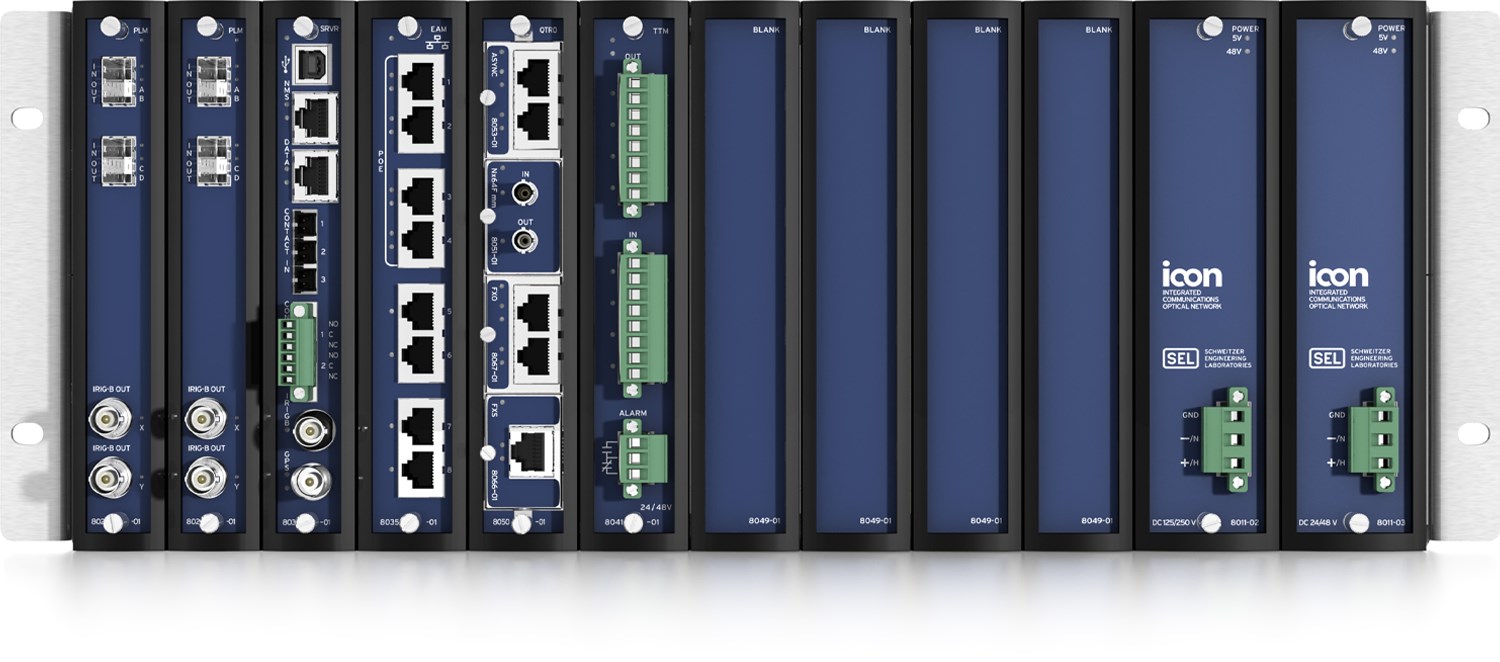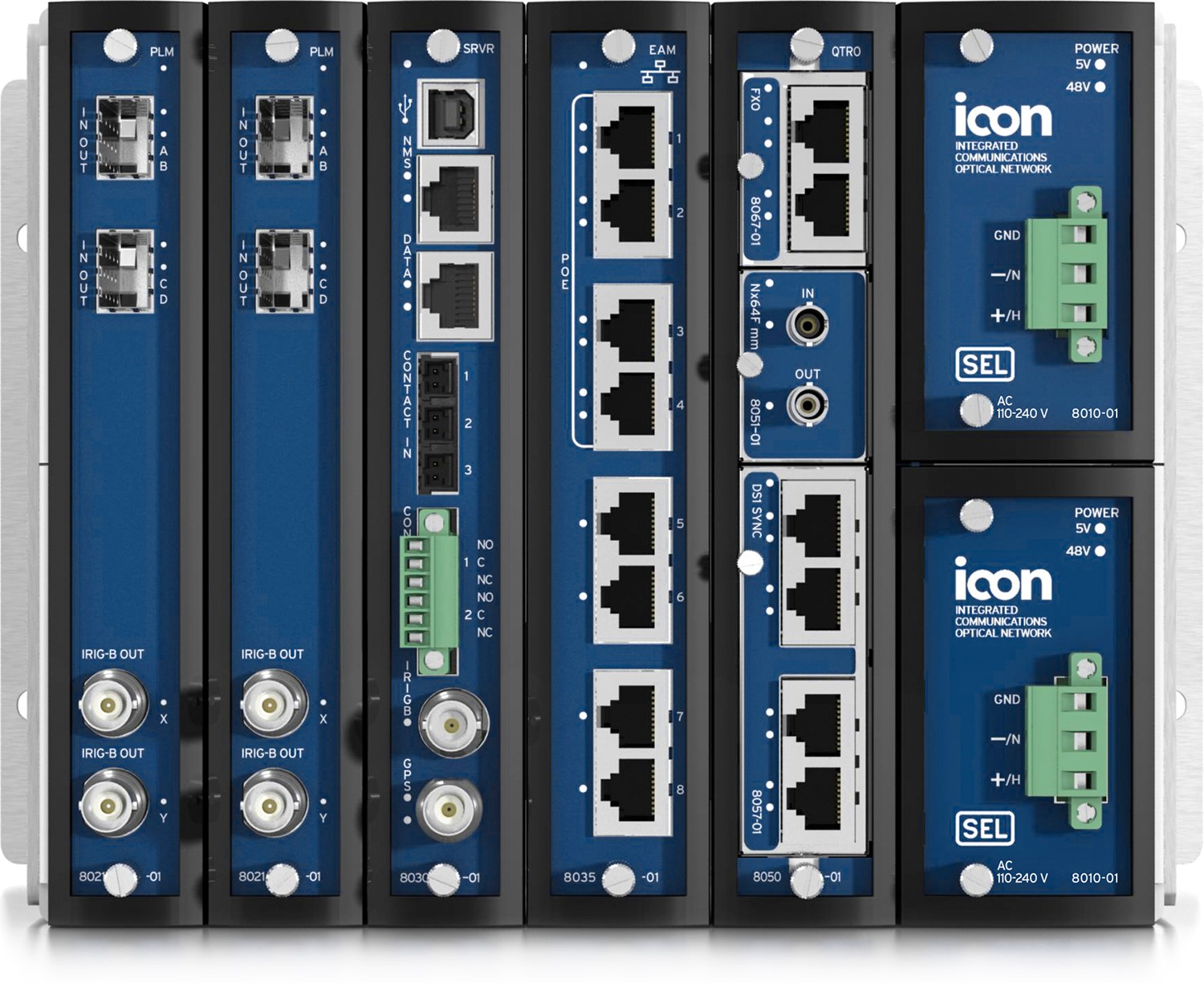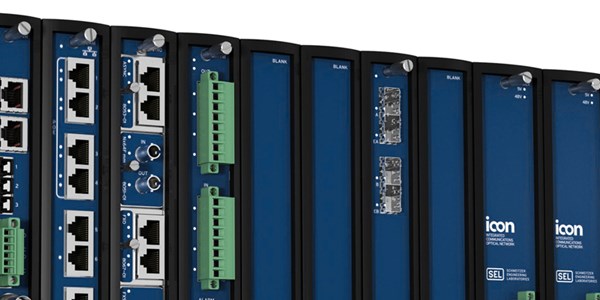ICON
Integrated Communications Optical Network
The SEL ICON is a wide-area-networking multiplexer optimized for industrial and utility applications. You can configure the ICON to operate as a time-division multiplexing (TDM) or Ethernet multiplexer, enabling the platform to address the following network usage cases:
- Segregated operational technology (OT)—SONET transport
- Segregated OT—Ethernet transport
- Converged information technology (IT)/OT
- Migrating analog leased services
- Network-distributed time synchronization
ICON virtual synchronous networking (VSN) preserves the performance characteristics of TDM when converting to Ethernet as a transport protocol.
In addition to encapsulating critical services into the VSN container for deterministic transport, the ICON can allocate noncritical services, like video and SCADA, into standard IEEE 802.1Q Ethernet outside the VSN container. This enables the ICON to efficiently use bandwidth for Ethernet services and provide the flexibility to support the wide-area transport of all substation services.
By combining TDM and Ethernet transport options with a comprehensive range of data interfaces, the ICON makes it easy to migrate legacy network technologies to a converged IT/OT packet-based solution. The ICON interoperates with Multiprotocol Label Switching (MPLS) or Carrier Ethernet-based core networks to provide a hardened OT edge multiplexer for mission-critical applications.
SEL-5051/5052 Client/Server Network Management System (NMS) Software
Starting At
$7,480Transmission Line Protection—Implement current differential protection and direct transfer trip schemes with SEL relays. The ICON can transport relay teleprotection circuits across SONET, Ethernet, T1, and E1 networks. You can apply the ICON Transfer Trip Module (TTM) to sense or assert contact closures for pilot protection schemes. The ICON network monitors and reports channel latency in real time. Selecting the shortest path between terminals as the primary path ensures that the system always reverts back to your primary configuration in the event of a path failure and subsequent restoration. These features, combined with robust IEEE 1613 environmental operating specifications, make the ICON ideal for critical power system applications.
Time Distribution—Distribute time information over the ICON WAN while maintaining accuracy better than 1 µs. You can use the ICON in power utility protection and monitoring applications, such as power system disturbance recording, synchrophasor measurement, and Sequential Events Records (SER) data collection. Each ICON node can be timed using GPS, IRIG-B, or the IEEE 1588 Telecom Profile. Each ICON node can generate IRIG-B and IEEE 1588 Power Profile time references for IEDs in substations. Timing accuracy of ‹1 µs can be maintained if the ICON network is locked to a suitable reference (GPS or Stratum 1 clock). With multiple time references, the ICON network is resilient to localized or wide-area GPS outages, equipment failure, and GPS spoofing. The SEL-5051/5052 enables centralized monitoring and troubleshooting of time synchronization.
Security Monitoring—Use the ICON to build substation security applications. You can connect fence, motion, panel, and door sensors to the SEL-2440 DPAC Discrete Programmable Automation Controller digital inputs and can connect strobes, sirens, and substation lighting to the control outputs. The ICON network can then communicate information back to a SCADA master.
IEC 61850 Network Optimization—Ensure optimal performance of IEC 61850-based systems by supporting VLANs and Ethernet Pipes (Epipes). Epipes can contain and isolate Layer 2 broadcast commands, such as IEC 61850 Generic Object-Oriented Substation Event (GOOSE) messages, from all other noncritical traffic on the network, ensuring very-low-latency data communications paths between intelligent electronic devices (IEDs).
Communications Aggregation—Consolidate legacy DS1/E1 and DS0/E0 circuits between locations onto the ICON WAN to replace leased circuits and optimize network performance. The ICON FXO, FXS, and 4-Wire VF Modules support legacy analog telephone, PBX, fax, and modem circuits. The ICON accepts channelized DS1 and E1 circuits from any source, and you can groom the individual DS0/E0 circuits to terminate anywhere within the network.
Synchrophasor Communication—Transport synchronized phasor measurements (synchrophasors) to provide a real-time measurement of electrical quantities across a power system. You can use these time-synchronized measurements for analysis and control of the power system. The ICON provides all the necessary timing and Ethernet communications for synchrophasor information reporting. The ICON distributes time across the entire network and can maintain better than 1 µs accuracy among all terminals in the network when using SONET or Ethernet transports. This allows synchrophasor systems to continue to operate accurately even in the event of a local or system-wide GPS failure.
Features
-
- 1
Enhanced Protected Line Modules
- 2
Async Module for EIA-232, EIA-422, and EIA-485 circuits
- 3
IEEE 1613-compliant packaging
- 4
Internally wetted contact inputs
- 5
IEEE C37.94 teleprotection interface
- 6
FXS and FXO Submodules
- 7
Transfer Trip Module
- 8
IRIG-B output ports
- 9
Server Module for network management, alarm I/O, and a GPS time reference
- 10
8-port Ethernet switch
- 11
Seven slots for access modules
- 12
Dual redundant power supplies
123456789101112
-
-
- 1
Enhanced Protected Line Modules
- 2
Server Module
- 3
Two slots for access modules (Ethernet Access and Quattro Modules shown)
- 4
Dual redundant power supplies
1234
-
ICON - Demo Sign Up Link
ICON Virtual Demonstration
Sign up for a personalized virtual demonstration to see how the ICON can be applied in your system.
Details
Minimum Software Version
Latest Firmware Versions
There are no firmware versions available for this product.
| Product | Revision | Firmware ID | Date Available | Serial Number |
|---|---|---|---|---|
| SEL-8020-01 | R113-V0 | SEL-8020-01-R113-V0-Z008001-D20180511 | 5/31/18 | ~1181510001 |
| SEL-8021-01 | R116-V0 | SEL-8021-01-R116-V0-Z010002-D20250217 | 3/6/25 | ~1250650001 |
| SEL-8021-01V | R302-V0 | SEL-8021-01-R302-V0-Z009001-D20250217 | 3/6/25 | ~1250650001 |
| SEL-8022-01 | R103-V0 | SEL-8022-01-R103-V0-Z004002-D20241025 | 11/2/24 | ~1243070001 |
| SEL-8029-01 | R101-V0 | SEL-8029-01-R101-V0-Z001001-D20131105 | 11/16/13 | ~1133200001 or ~3133200001 |
| SEL-8030-01 | R131-V0 | SEL-8030-01-R131-V0-Z024007-D20250110 | 1/25/25 | ~1250250001 |
| SEL-8035-01 | R107-V0 | SEL-8035-01-R107-V0-Z003002-D20180815 | 8/25/18 | ~1182370001 |
| SEL-8036-01 | R104-V1 | SEL-8036-01-R104-V1-Z004001-D20250124 | 3/5/25 | ~1250640001 |
| SEL-8036-02 | R104-V1 | SEL-8036-02-R104-V1-Z004001-D20250124 | 3/5/25 | ~1250640001 |
| SEL-8041-01 | R105-V0 | SEL-8041-01-R105-V0-Z004001-D20210212 | 9/24/21 | ~1212670001 |
| SEL-8041-04 | R105-V0 | SEL-8041-04-R105-V0-Z004001-D20210212 | 9/24/21 | ~1212670001 |
| SEL-8051-01 | R106-V0 | SEL-8051-01-R106-V0-Z003001-D20171004 | 10/7/17 | ~1172800001 |
| SEL-8051-02 | R106-V0 | SEL-8051-02-R106-V0-Z003001-D20171004 | 10/7/17 | ~1172800001 |
| SEL-8051-11 | R100-V2 | SEL-8051-11-R100-V2-Z001001-D20221130 | 12/9/22 | ~1223420001 |
| SEL-8051-12 | R100-V2 | SEL-8051-12-R100-V2-Z001001-D20221130 | 12/9/22 | ~1223420001 |
| SEL-8053-01 | R109-V0 | SEL-8053-01-R109-V0-Z004001-D20240216 | 3/9/24 | ~1240690001 |
| SEL-8053-02 | R101-V0 | SEL-8053-02-R101-V0-Z001001-D20240216 | 3/9/24 | ~1240690001 |
| SEL-8053-11 | R101-V0 | SEL-8053-11-R101-V0-Z001001-D20240216 | 3/9/24 | ~1240690001 |
| SEL-8053-12 | R101-V0 | SEL-8053-12-R101-V0-Z001001-D20240216 | 3/9/24 | ~1240690001 |
| SEL-8055-01 | R100-V0 | SEL-8055-01-R100-V0-Z001001-D20190228 | 4/16/19 | ~1191060001 |
| SEL-8056-01 | R100-V0 | SEL-8056-01-R100-V0-Z001001-D20180711 | 5/2/19 | ~1191220001 |
| SEL-8057-01 | R102-V0 | SEL-8057-01-R102-V0-Z001001-D20240902 | 8/17/24 | ~1242290001 |
| SEL-8057-02 | R103-V0 | SEL-8057-02-R103-V0-Z002002-D20220525 | 9/1/22 | ~1222440001 |
| SEL-8057-03 | R100-V1 | SEL-8057-03-R100-V1-Z001001-D20250110 | 1/25/25 | ~1250250001 |
| SEL-8057-11 | R101-V0 | SEL-8057-11-R101-V0-Z001001-D20240902 | 8/28/24 | ~1242410001 |
| SEL-8057-12 | R101-V0 | SEL-8057-12-R101-V0-Z001001-D20230407 | 4/12/23 | ~1231020001 |
| SEL-8057-14 | R100-V0 | SEL-8057-14-R100-V0-Z001001-D20231221 | 1/13/24 | ~1240130001 |
| SEL-8057-15 | R100-V1 | SEL-8057-15-R100-V1-Z001001-D20241113 | 12/4/24 | ~1243390001 |
| SEL-8065-01 | R104-V0 | SEL-8065-01-R104-V0-Z002001-D20150901 | 9/9/15 | ~1152520001 |
| SEL-8065-02 | R100-V0 | SEL-8065-02-R100-V0-Z001001-D20190827 | 12/4/19 | ~1193380001 |
| SEL-8065-11 | R100-V0 | SEL-8065-11-R100-V0-Z001001-D20221104 | 12/14/22 | ~1223480001 |
| SEL-8065-12 | R100-V0 | SEL-8065-12-R100-V0-Z001001-D20221104 | 12/14/22 | ~1223480001 |
| SEL-8066-01 | R104-V0 | SEL-8066-01-R104-V0-Z001001-D20230630 | 7/8/23 | ~1231870001 |
| SEL-8067-01 | R104-V0 | SEL-8067-01-R104-V0-Z001001-D20150512 | 5/29/15 | ~1151490001 |
The Firmware IDs for older versions of the firmware can typically be found in Appendix A of the instruction manual.
Minimum Software Version
Instruction Manuals
Sales Resource Central access is required to view the content in this tab.
Sales Resource Central| Cable Part Number | Termination | Notes | Used With | Schematic |
|---|---|---|---|---|
| C808 | LC or ST | 62.5/125 µm multimode fiber-optic cable, single-fiber or dual-fiber, 1 to 300 m | PLM, EPLM, EBAM, Nx64F | View |
| C809 | LC or ST | 9/125 µm single-mode fiber-optic cable, single-fiber or dual-fiber, 1 to 300 m | PLM, EPLM, EBAM, Nx64F | View |
| C953 | BNC–BNC | IRIG-B cable, 1 to 500 ft | PLM, EPLM, Server | View |
| C965 | TNC–TNC | GPS cable, 1 to 340 ft | Server | View |
| CA605R | RJ45–RJ45 | Cat 5e Ethernet cable, 1 to 330 ft | EAM, EBAM, Server | View |
| C664 | USB-A–USB-B | USB cable, 6.5 ft | Server | View |
| C575 | Molex–Tinned Wires | Contact input, Molex 50579402 two-position connector, 3 to 100 ft | Server | View |
| C622R | RJ48C–RJ48C | DS1/T1/E1 cable, 1 to 330 ft | DS1/E1 Async/Sync/ Psync | View |
| C649 | RJ48C–Tinned Wires | DS1/T1/E1 cable, 1 to 330 ft | DS1/E1 Async/Sync/Psync | View |
| C394 | RJ48C (Double)–RJ48C Female | DS1/T1 combiner cable for redundant (1 × 1 protected) connections. Use C394 with C622R or equivalent RJ48C to RJ48C crossover cable. | DS1 Psync | View |
| C437 | RJ45–DB25 Female | EIA-422 cable, 1 to 100 ft | 422 Sync | View |
| C471 | RJ45–DB37 Female | EIA-422 cable, 1 to 6 ft | 422 Sync | View |
| C392R | RJ48C–DB25 Female | ITU-T G.703 cable, 1 to 330 ft | G.703 | View |
| C616R | RJ45–DB9 Male | EIA-232 single-circuit cable for connecting to a DTE device, 1 to 100 ft | Async Data, Async-CB | View |
| C609R | RJ45–DB9 Female | EIA-232 single-circuit cable for connecting to a DTE device, 1 to 100 ft | Async Data, Async-CB | View |
| C612M | RJ45–DB9 Male | EIA-232 single-circuit with IRIG-B cable for connecting to a DTE device, 1 to 100 ft | Async Data | View |
| C612 | RJ45–DB9 Female | EIA-232 single-circuit with IRIG-B cable for connecting to a DTE, 1 to 100 ft | Async Data | View |
| C607R | RJ45–Tinned Wires | EIA-232 triple-circuit or EIA-422/485 (2-wire or 4-wire circuits) cable for connecting to a terminal block on a DCE or DTE device, 1 to 100 ft | Async Data, Async-CB, 4-Wire VF, 4-Wire Bridging | View |
| C629N | RJ45–RJ45 | EIA-232/422/485 crossover cable for connecting to a DCE device or another ICON Async Data module, 1 to 100 ft | Async Data, Async-CB | View |
| C480 | RJ45–DB9 Female | EIA-232 cable with mounting nuts for connecting to a DCE transceiver or existing cable, 1 to 6 ft | Async Data, Async-CB | View |
| C611 | RJ45–DB9 Female (Double) | EIA-232 dual-circuit cable for connecting to two DTE devices, 3 to 100 ft | Async Data, Async-CB | View |
| C611M | RJ45–DB9 Male (Double) | EIA-232 dual-circuit cable for connecting to two DTE devices, 3 to 100 ft | Async Data, Async-CB | View |
| C648 | RJ45–DB9 Male (Triple) | EIA-232 cable for connecting to three DTE devices, 1 to 50 ft | Async Data, Async-CB | View |
| C612T | RJ45–DB9 Male With BNC | EIA-232 with IRIG-B cable for connecting to a DTE device, 2 to 100 ft | Async Data | View |
ICON - Software Tab
Configuration Software
SEL-5051/5052 Client/Server Network Management System (NMS) Software
Manage SEL ICON networks with either standalone SEL-5051 Client Software or a combination of SEL-5051 Client and SEL-5052 Server Software. SEL-5051 Client Software connects to SEL-5052 Server Software to provide an efficient solution for managing network access for multiple users.
Learn more and download on the SEL-5051/5052 software page.



